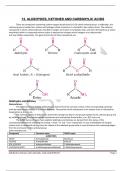Exam (elaborations)
12. Aldehydes, Ketones and Carboxylic acids-anil-hsslive Questions with 100% Actual correct answers | verified | latest update | Graded A+ | Already Passed | Complete Solution
- Course
- Institution
12. Aldehydes, Ketones and Carboxylic acids-anil-hsslive Questions with 100% Actual correct answers | verified | latest update | Graded A+ | Already Passed | Complete Solution
[Show more]



